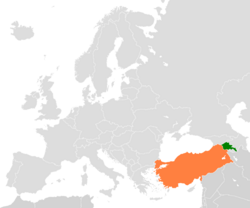Armenia-Turkey relations facts for kids
  |
|
 |
|
| Armenia | Turkey |
The relationship between Armenia and Turkey has been difficult for many years. A big reason for this is a disagreement over a region called Nagorno-Karabakh, where Turkey supports Azerbaijan. Another major issue is Armenia's view of very sad historical events that happened during the time of the Ottoman Empire.
Despite these challenges, on October 10, 2009, Turkey and Armenia signed an agreement. This agreement was meant to start a new, friendly relationship between the two countries and open their borders. However, these efforts to improve relations later stopped when Armenia decided to pause the process.
Contents
Understanding Armenia and Turkey's Relationship
The relationship between Armenia and Turkey has a long and complex history. Both countries are neighbors, but they have faced many disagreements over the years.
Historical Disagreements
One of the main reasons for the tension is how each country views events from the early 20th century. During World War I, many Armenians living in the Ottoman Empire (which is now Turkey) suffered greatly. Armenia believes these events were a planned effort to destroy their people. Turkey, however, has a different view of what happened. This difference in understanding is a big part of why their relationship is strained.
The Nagorno-Karabakh Conflict
Another important issue is the conflict over the Nagorno-Karabakh region. This area is located in the South Caucasus and has been a source of conflict between Armenia and Azerbaijan. Turkey strongly supports Azerbaijan in this dispute. This support adds to the difficulties in the relationship between Armenia and Turkey.
Attempts to Improve Relations
Even with these challenges, there have been times when both countries tried to make things better.
The 2009 Peace Accord
In 2009, Armenia and Turkey took a big step towards peace. Their leaders signed an agreement in Zurich, Switzerland. This agreement was called the "Protocols on the establishment of diplomatic relations" and the "Protocol on the development of relations."
- The main goal was to start official diplomatic relations, meaning they would have ambassadors and work together like most countries do.
- They also planned to open their shared border, which had been closed for a long time. This would allow people and goods to move more freely between the two nations.
- The agreement also aimed to create a group of experts to study the historical events that caused so much disagreement.
Why the Accord Didn't Work
Sadly, the hopes for a new relationship didn't last. Even though the agreement was signed, it was never fully put into action.
- Both countries faced pressure from different groups within their own nations.
- Armenia eventually announced in 2018 that it was suspending the agreement. This meant they stopped the process of trying to make the agreement work.
- As a result, the borders remain closed, and official diplomatic relations have not been established.
What the Future Holds
The relationship between Armenia and Turkey remains a topic of discussion for leaders and people around the world. Many hope that one day, these two neighboring countries can find a way to live in peace and cooperation.
Images for kids
-
Abandoned since 1915, the tenth-century Armenian Cathedral of the Holy Cross on Akhtamar Island underwent a controversial restoration in 2006, paid for by the Turkish Ministry of Culture.
-
Fedayee group fighting under the ARF banner. Text in Armenian reads "Azadoutioun gam mah" (Liberty or Death).
-
Mount Ararat was in ancient and medieval times at the center of Armenia. Today, it is located in Turkey, though still towering over the Armenian capital of Yerevan.







